Institut für Materielle Kultur
Lehrauftrag an der Carl von Ossietzky Universität Oldenburg seit 2014
Die Carl von Ossietzky Universität wurde 1973 gegründet. Damit gehört sie zu den jungen Hochschulen Deutschlands. Ihr Ziel ist es, Antworten zu finden auf die großen Fragen der Gesellschaft im 21. Jahrhundert – mit interdisziplinärer Spitzenforschung und Lehre.
Die Forschenden und das Personal der Verwaltung arbeiten Hand in Hand und fachübergreifend zusammen. Viele sind in die Forschung eingebunden – beispielsweise in Sonderforschungsbereiche, Forschergruppen, europäische Projekte oder den Exzellenzcluster.
Die Universität arbeitet eng mit mehr als 200 Hochschulen weltweit zusammen. Außerdem ist sie mit außeruniversitären Institutionen in Forschung, Bildung, Kultur und Wirtschaft verbunden. Der Forschungsstandort wird zusätzlich gestärkt durch die Ansiedlung des Helmholtz-Instituts für Funktionelle Marine Biodiversität, eine Max-Planck-Forschernachwuchsgruppe und drei Fraunhofer-Arbeitsgruppen. Hinzu kommt ein Virtuelles Helmholtz-Institut.
Rund 16.000 Studierende bereitet die Universität auf das Berufsleben vor. Das Spektrum reicht von den Geistes- und Kulturwissenschaften über die Wirtschafts-, Rechts- und Sozialwissenschaften bis hin zu Mathematik, Informatik, den Naturwissenschaften und der Medizin.
Lehrauftrag am Institut für Materielle Kultur seit 2014
Carl von Ossietzky Universität Oldenburg
Fakultät III – Sprach- und Kulturwissenschaften
Institut für Materielle Kultur
Workshops als ganztägige Seminare im Restaurierungsatelier
ART-Restauro in Rastede
Thema: „Präventive Konservierung und Probleme der Restaurierung“
Folgende Übungen und Maßnahmen werden im Restaurierungsatelier regelmäßig praktiziert und erläutert:
- Bedeutung und Auswertung der Klima- und Lichtverhältnisse
- Modernes Risiko- und Sammlungsmanagement
- Schadensfaktoren/Schadenspotenzial in Museen und Ausstellungsorten
- Museumsdepot im Kontext der Präventiven Konservierung
- Verpackung der Kunstgegenstände beim Transport
- Erläuterung der Fachterminologie
- Austausch der Informationen über die Fachliteratur sowie Adressen von Institutionen, Hochschulen und Museen, Quellen, Netzwerkbildung
- Erläuterung der Vergoldungs- und Versilberungstechniken
- Trockene Reinigung der Rückseite eines Gemäldes
- Festigung der lockeren Malschicht
- Praktische Übungen mit unterschiedlichen Arbeitsmaterialien:
- B.: Zusammenbau eines Keilrahmens, Aufspannen der Leinwand, Applikation von unterschiedlichen Klebstoffen und Konsolidierungsmitteln an einem Ölgemälde
Impressionen:
Alle Fotos wurden von Ludmila Henseler aufgenommen und mit Genehmigung der Studierenden veröffentlicht.
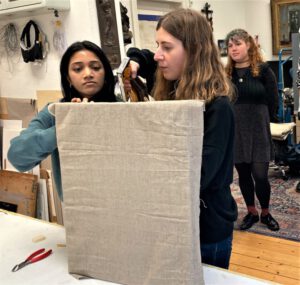
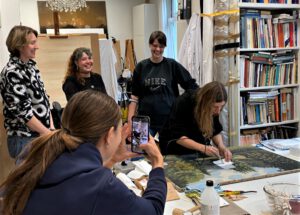
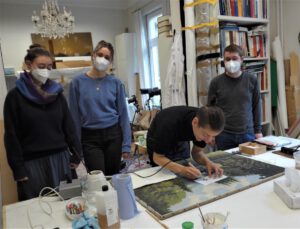
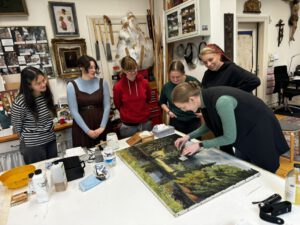
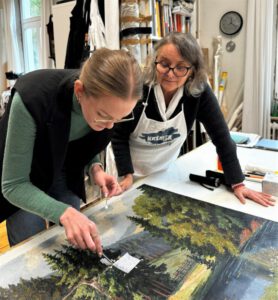
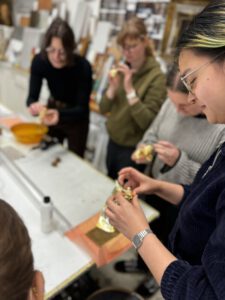
Arbeiten mit GOLD / Blattgold fasziniert immer….
